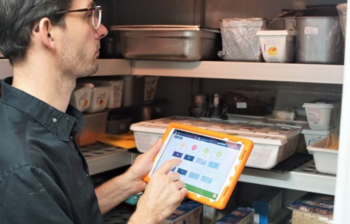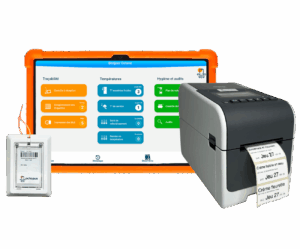Cold rooms: how to optimize their maintenance?
Managing supplies, teams, the menu, service… and maintaining cold rooms — but how to optimize it? In a restaurant or production lab, cold rooms are indispensable, yet maintenance often comes last, done only during the big closing cleanup.
Why is maintenance and upkeep of your cold rooms important? ❄️
To avoid overconsumption caused by poor settings or clogging. These issues can be detected by a professional, who can also advise you on reducing energy use. Nowadays, saving even a few kWh is always welcome.
To minimize equipment wear: Regular checks and cleanings of your refrigeration unit help extend equipment lifespan and reduce motor breakdowns.
To avoid power loss: Proper maintenance ensures optimal cooling performance. Poorly maintained cold rooms may fail to operate at full capacity.
To comply with safety and environmental standards: It is mandatory to regularly check the refrigeration circuit’s tightness to prevent refrigerant leaks.
To limit the risk of food contamination: A cold room kept at the correct temperature reduces bacterial growth risks — a key element of the HACCP method. It’s important to check cold room temperatures daily because some bacteria can develop even at low temperatures.
Which bacteria resist cold? ❄️
Listeria monocytogenes is a widespread bacterium that resists many environmental conditions. Its particularity is its ability to multiply at refrigeration temperatures.
Listeria is cold-resistant and responsible for some of the most common foodborne illnesses. It can be found in various foods, raw or processed: dairy products, meats, vegetables, fish, and seafood.
The highest risk products are ready-to-eat items such as raw milk cheeses and raw meats. Cooked foods should not be neglected either, as they can remain contaminated due to insufficient heat treatment or cross-contamination after cooking.
How does listeria develop?
Listeria contamination can occur at any stage of the food chain.
It grows depending on storage conditions. It can multiply between -2°C and +45°C. However, temperatures below +4°C significantly slow its growth. Hence the importance of regularly recording cold room temperatures.
Other bacteria may also grow under these conditions, but listeria remains a frequent contaminant capable of causing severe infections.
Cold room storage temperatures?️
What temperatures should my cold rooms have?
Here are some regulatory maximum storage temperatures (extracted from GBPH):
Maximum temperatures for frozen foods:
- Ice creams, frozen creams – -18 °C
- Frozen minced meats and meat preparations – -18 °C
- Frozen fishery products – -18 °C
- Other frozen foods – -12 °C
Note: The temperature indicated is the maximum for the frozen product with no lower limit. Once thawed, the product becomes fresh and must be consumed within 48 hours.
Maximum temperatures for refrigerated foods ❄️
- 0°C – +2°C: Minced meats, packaged fresh fish products, cuts, fresh fish, thawed unprocessed fishery products, cooked and refrigerated crustaceans and mollusks.
Note: Fresh fish should be stored separately from other fresh products, repackaged in sealed containers, and kept on ice.
- 0°C – +3°C: Offal from domestic and game ungulates (farmed or wild), prepared culinary products made in advance.
- 0°C – +4°C: Meat preparations, whole carcasses and large cuts, egg products except UHT, raw milk for direct consumption, poultry meat (including small farmed game with feathers), lagomorph meat (rabbits, including small furred farmed game), ratites (e.g., ostrich), and small wild game, and other highly perishable foods.
- 0°C – +7°C: Meat from domestic ungulates, game ungulates (farmed or wild).
- Temperature set by manufacturer or packer: Pasteurized milk, aged cheeses.
Note: The lower limit of refrigerated food storage must be at the freezing start temperature specific to each product category.
Tolerance of +2°C is only allowed occasionally and for a short time. Any exceedance must trigger corrective actions.
Should hot products be placed directly in cold rooms?
Hot products must not be placed directly in cold rooms. Rapid cooling is essential to lower temperature quickly and avoid raising the cold room’s temperature.
Cooling should not exceed two hours before refrigeration.
However, it is possible to place ambient temperature foods in cold rooms, such as products handled at room temperature or preparations finishing cooling. To avoid temperature spikes, the quantity introduced should be controlled.
Should cold room temperature settings be changed during a heatwave? ☀️
It is important not to change your cold room settings during heatwaves. This risks higher energy consumption and strain on the motor, which can cause breakdowns.
In hot weather, follow these good practices:
- Open cold room doors as infrequently and briefly as possible.
- Defrost cold rooms if they lack automatic defrost technology.
- Check temperatures multiple times per day.
If problems occur: corrective actions
If cold room temperature limits are exceeded, check the core temperature of the products. The regulatory tolerance of +2°C must not be exceeded.
Any exceedance must trigger immediate corrective actions documented with what you did (e.g., verify door closure, call a refrigeration technician in case of failure).
Actions also concern non-compliant products: if product temperature is 8°C, discard it; if still 4°C, move it to another cold room.
Temperature anomalies can happen — what matters is implementing corrective measures.
For enhanced temperature monitoring, consider equipping cold rooms with connected sensors. Octopus HACCP can help secure your stock with wireless temperature loggers, which take readings every 10 minutes and alert you on deviations.
Cold room storage and organization
It is advisable to store products by category in cold rooms and apply the FIFO principle (First In, First Out).
After product reception, unpack and place items in closed bins — storing cartons in cold rooms is prohibited.
Products should be sectorized by family: dairy, fruits and vegetables, meats and charcuterie, opened products, thawing items, etc.
Examples of sectorization:
Fragile items like desserts, prepared dishes, cooked meats should be stored on upper shelves. Charcuterie and raw meats on middle shelves. Low-risk foods like vegetables on lower shelves.
Storage order should also consider product cleanliness: cleaner items on top, dirtier (e.g., soil-covered vegetables) below.
Storing products directly on the floor is forbidden; use pallets or racks to elevate goods.
Seal integrity checks: a legal requirement
It is mandatory to check the tightness of refrigeration equipment containing:
- 2 kg or more of HCFC refrigerants
- 5 tons or more of HFC or PFC refrigerants
The February 29, 2016 decree sets periodic seal checks.
For example, equipment with 2–30 kg HCFC charge must be checked annually.
Checks must be performed by certified technicians holding capacity certificates (Article R543-99, Environmental Code), who provide control certificates after verification.
Cold room cleaning and disinfection plan
Surface cleaning
Cleaning methods depend on surface type. Avoid wetting electronic parts.
For steel, stainless steel, acrylic, or polycarbonate surfaces, wash with lukewarm water and mild soap using a soft cloth or chamois. Avoid abrasive products, alcohol, acetone, or solvents that cause corrosion or scratches.
Use glass cleaners for glass surfaces to prevent lime scale stains.
Cleaning electronic components
Condenser: Clean at least monthly. Remove residues like blood, milk, or meat bits to prevent odors, corrosion, and increased energy use.
Use vacuum cleaners, air blowers, or soft brushes.
Evaporator: Poor maintenance can cause icing, temperature drops, and gas leaks. Check regularly and defrost when iced.
Defrost manually or shut down the cold room for natural defrosting. Ensure the evaporator is completely dry before restarting.
Maintenance contracts
Consider maintenance contracts for reliable equipment operation. They offer professional intervention plus regular checks.
Key checks include:
- Vibration and noise level monitoring;
- Compressor oil checks (level and acidity);
- Cleaning of the refrigeration circuit if clogged;
- Evaporator cleaning to prevent icing;
- Temperature verification;
- Refrigeration circuit pressure checks;
- Inspection of supports and fastenings;
- Safety elements control (indicator lights, alarms tests);
- Germicidal treatment and disinfection of condensation trays.
I hope these tips help you better maintain your cold rooms. For improved temperature logging, manually or via connected sensors, don’t hesitate to contact us.



